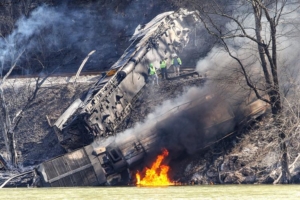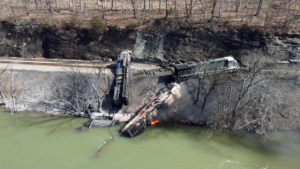Rail Safety Legislation
By Heather Sprouse, Ohio River Coordinator, hsprouse@wvrivers.org
The Ohio River Valley and its tributaries are no strangers to drinking water impacts from the transportation of hazardous substances. Close to home and throughout the region, our rivers and streams are vulnerable to contamination events and need to be protected. Millions of people and wildlife depend on these waters.
Photo credit: Jennifer Harnish
On March 8th, a CSX train collided with a rockslide and derailed in the heart of the New River Gorge National Park, leaking diesel fuel into the New River, a tributary of the Kanawha River and then the Ohio River. All three crew members on board the train were injured. Just this week, three barges jammed against a dam on the Ohio River, off the shore of Louisville, KY. One of the partially submerged barges was carrying more than 1,000 tons of hazardous methanol, a solvent used to make plastic.
Nearly two months have passed since the release of five chemicals in a train derailment in East Palestine, Ohio. That release included butyl acrylate (used in making paints and sealers) which leaked into two streams just 16 miles from the Ohio River. The Ohio River Valley Water Sanitation Commission (ORSANCO) tracked a plume of butyl acrylate as it made its way downriver, causing multiple water systems to shut off their drinking water intake, such as Huntington, WV. Residents of East Palestine continue to report symptoms of illness such as headaches, coughing and anxiety.
Incidents such as these highlight the need for additional safeguards in the transport of hazardous substances to protect West Virginians. Federal decision makers are considering updating regulations to prevent these chemical disasters that threaten human and ecosystem health. Two federal bills have been proposed to improve the safety of chemicals being transported by trains, many of which pass by through our rural towns and small cities. The Railway Safety Act (RSA) has been introduced in the Senate and the Reducing Accidents in Locomotives (RAIL) Act has been introduced in the House of Representatives.
Photo credit: Austin Simms





